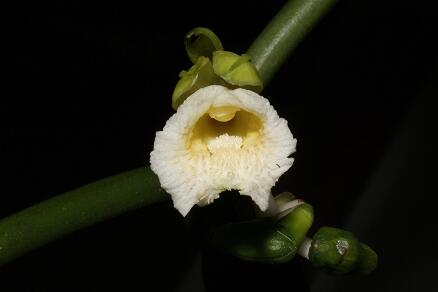Orchidaceae
Vanilla ribeiroi Hoehne

Kingdom: Plantae Rank: Species Parent: Vanilla Status: Invalid Reason: unverified
Vegetative Morphology
Habit: Plant a vine, generally loosely climbing understory trees. Climbs via aerial roots produced from each node, short, stout, white, unbranched. Terrestrial roots emerging from lower stems and entering superficially into substrate, branched and extensive.
Main axis: Stems succulent ca 0.5 – 0.8 cm in diameter, internodes 10 – 15 cm.
Leaves: Leaves produced from each node opposite to roots, succulent, dark green, held at 0 to 15 degrees below horizontal, ca. 1.5 x 8.5cm – 2 x 14 cm; blade lanceolate, apex acute, margin entire, texture smooth.
Reproductive Morphology
Inflorescence: Inflorescences racemose, axillary only, fleshy, green, sessile ca 1 to 20-flowered, non-floriferous bracts generally two; bracts green, triangular, ca. 1.8 cm long and 1 cm wide.
Flowers: Flowers resupinate, somewhat stiff, fleshy, arranged spirally, non-fragrant, span ca 4 – 5 cm; pedicel with ovary, white at base to three-quarters length then fading to green, ca 0.5 x 4.5 cm; buds green; dorsal sepal green, oblanceolate, apex rounded, ca 1 x 5 cm; lateral sepals green, oblanceolate, apex rounded, ca 1.4 x 4.7 cm, petals green, oblanceolate-linear, ca 1 x 4.6 cm, ribbed dorsally, lip white, stout, ca. 3.8 cm long, flabellate when flattened, fused with column for two-thirds length dorsally, distinct patch of thickened hairs ca 1.5 x 1 cm at opening; callus 0.5 x 0.4 cm, with white hairs; column 2.7 cm long, 0.4 cm wide, ventral surface hirsute; rostrellum thick, wide, stigmatic surface two-lobed.
Fruit: Fruit fleshy, cylindrical in cross-section, green when immature.
Other
Distribution: Previously collected from indundated areas of Mato Grosso, Brazil, near the Bolivian border. Of the endemic terrestrial Vanilla species, it is the most tolerant of substantial water level fluctuations and we have documented its prescence in at least four habitats, all with varying flooding regimes. We have documented individuals in permanently inundated M. flexuosa wetlands on histosols, aseasonally inundated M. flexuosa wetlands on gleysols, seasonally inundated “shebonales” dominated by Attalea sp. (Arecaceae), and small forest patches (usually in association with arborescent palms) characterized by clayey soils that retain water after precipitation events. Although this is one of two Vanilla species not restricted to M. flexuosa wetlands it is restricted to areas with hydromorphic soils.
Ecology: The flowering season occurs in mid-August to September, just prior to the main flowering season of V. pompona subsp. grandiflora, and their phenologies may partially overlap. Ephemeral flowers open singly and last a single day. Pollination rates are low, estimated to be about one percent based on three individuals studied (Table 1). Nothing is known about pollinators, but such low pollination rates suggest outcrossing by insect vectors, probably Euglossine bees.
Notes: Vanilla ribeiroi is a Central Amazonian member of the American clade of fragrant Vanilla. The only type specimen for this species is damaged.